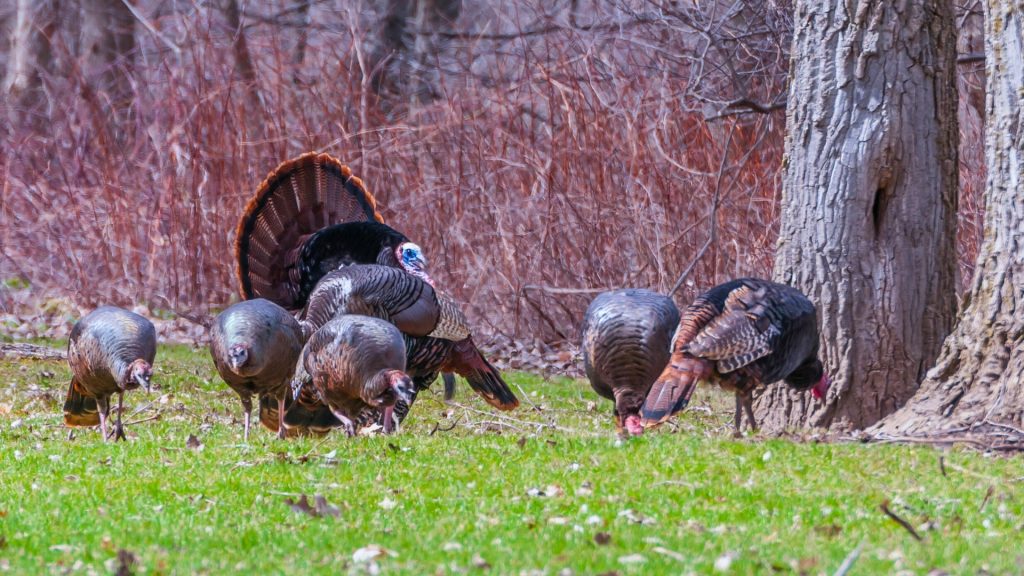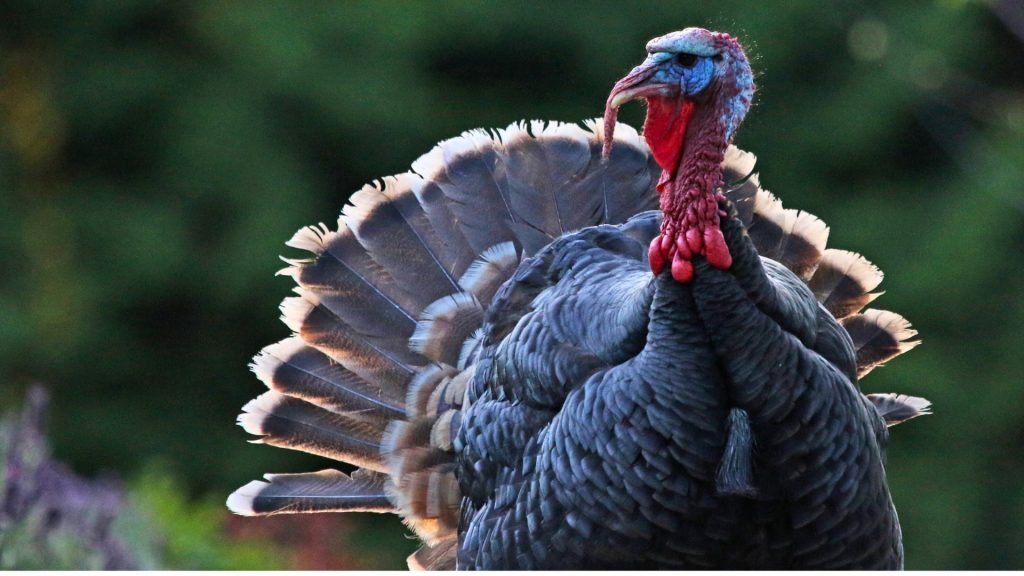Physical Characteristics
Wild turkeys (Meleagris gallopavo) are large birds that can grow up to 4 feet (1.2 meters) tall and weigh up to 20 pounds (9 kg). They have a distinctive bare head and neck with bright red, blue, and white coloration. The males, or toms, have long, sharp spurs on their legs and a large fan of feathers on their tail, which they use to attract females, or hens.
Behavior
Turkeys are social birds that live in flocks. They are active during the day and spend their time foraging for food and roosting in trees at night. They are able to fly short distances but prefer to run and can run up to 25 miles per hour (40 kilometers per hour). Wild turkeys are also known for their distinctive calls, which can be heard from far away.
Habitat
They are found in a variety of habitats, including forests, woodlands, and grasslands. They are native to North America and can be found throughout the United States, as well as in parts of Canada and Mexico.
Diet
Wild turkeys are omnivores and have a varied diet that includes insects, berries, seeds, and small animals such as frogs and snakes. During the winter months, they may also eat buds and twigs from trees.
Breeding
Breeding season for wild turkeys typically occurs in the spring. Male turkeys will display their feathers and make gobbling sounds to attract females. Once they have mated, the female will lay a clutch of eggs and incubate them for about a month. The chicks, or poults, will hatch and stay with their mother for several months until they are able to fend for themselves.
Ecological Role
Wild turkeys play an important ecological role in their habitat. They help to control insect and small animal populations, and their droppings provide nutrients for plants. Additionally, they are an important prey species for predators such as coyotes, foxes, and hawks.
Turkey Hunting
Turkey hunting is a popular sport in the United States, with over a million hunters pursuing these birds each year. Hunting seasons and bag limits are set by state wildlife agencies to ensure sustainable populations.
Turkey hunting requires a great deal of skill and patience, as these birds are wary and have keen senses. Hunters must use camouflage clothing and blinds to conceal themselves, and they often use decoys and calls to attract birds within range.
There are several different hunting methods for wild turkeys, including stalking, still-hunting, and calling. Some hunters prefer to use shotguns, while others use archery equipment. Each state has its own regulations regarding equipment and hunting methods.
It is important for hunters to practice ethical hunting practices, such as taking only legal birds, being aware of their surroundings, and taking clean shots to ensure a humane kill. Many hunters also follow a “fair chase” philosophy, which means they avoid using technology or other unfair advantages to increase their chances of success.
Wild turkey hunting not only provides a recreational opportunity for hunters, but also supports local economies through the sale of hunting licenses and equipment. Many hunters also donate a portion of their harvested birds to local food banks and charities.
Tracks & Signs
Wild turkey tracks are unique and resemble an “X” shape, with three forward-facing toes and a smaller rear-facing toe. The tracks typically measure around 4 to 5 inches (10 to 13 cm) in length, depending on the bird’s size.

Turkey scat, or feces, is a common sign of their presence. The droppings are cylindrical and dark in color, with a twisted appearance at the ends. Fresh droppings may have a moist appearance but dry out over time.
Conservation
Wild turkey populations declined in the early 1900s due to habitat loss and overhunting. However, conservation efforts, including habitat restoration and regulated hunting, have helped to bring the populations back to healthy levels. Today, wild turkeys are considered a conservation success story and a symbol of North America’s wildlife heritage.
Did You Know?
Wild turkeys are agile fliers, despite their size.
They can fly at speeds of up to 55 miles per hour (88 kilometers per hour) and travel long distances in search of food, water, or suitable roosting spots. However, they prefer to spend most of their time on the ground, foraging for food and walking or running with surprising speed.
They have remarkable vision.
Their eyes are positioned on the sides of their heads, providing them with a wide field of view, almost 270 degrees. This visual adaptation helps them detect movement and potential threats from a distance, making them wary and agile when escaping predators.
Image sources: Wikimedia Commons, AZ Animals




